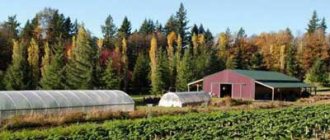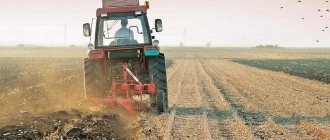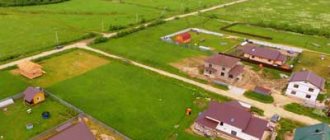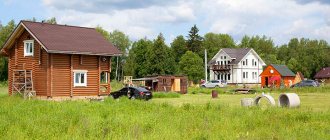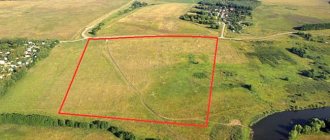Land suitable for plowing and use for growing crops
| Look up arable in Wiktionary, the free dictionary. |
Modern mechanized agriculture allows fields like this one in Dorset, England
Arable land
(from Latin: arabilis, "can be plowed") any land is capable of being plowed and crops grown.[1] Alternatively, for the purposes of agricultural statistics,[2] the term is often more precisely defined:
“Arable land is land for temporary agricultural crops (cultivated areas are counted only once), temporary meadows for mowing or pasture, land for markets and vegetable gardens and temporary fallow land (less than five years). Abandoned land resulting from shifting cultivation is not included in this category. The data for "Cropland" is not intended to indicate the amount of land that could potentially be cultivated."[3]
The shorter definition contained in the Eurostat glossary also refers to actual rather than potential uses: “land cultivated (ploughed or tilled) regularly, usually as part of a crop rotation system.”[4]
Non-arable land can sometimes be converted to arable land using methods such as loosening and tillage (breaking up) the soil, although in more extreme cases the degree of modification required to cultivate certain types of land can become prohibitively expensive.[5]In Britain arable land has traditionally been opposed[ by whom?
] with grazing land such as heathland that can be used for sheep farming but not as farmland.
Arable area
World map of arable land in percentage by country (2006)[6] Global agricultural area from 1600 to 2021
Further information: Land use statistics by country
According to the Food and Agriculture Organization of the United Nations, in 2013, the world's arable land accounted for 1.407 billion hectares of the 4.924 billion hectares of land used for agriculture.[7]
| Arable area (1000 km2)[8][9] | World | 13,866 | 13,873 | 13,880 | 13,962 | 13,958 | |
| 1 | India | 1,579 | 1,578 | 1,575 | 1,574 | 1,562 | 1,597 |
| 2 | United States | 1,631 | 1,605 | 1,598 | 1,602 | 1,551 | 1,522 |
| 3 | Russia | 1,216 | 1,218 | 1,200 | 1,215 | 1,197 | |
| – | European Union | 1,091 | 1,089 | 1,074 | 1,074 | 1,083 | |
| 4 | China | 1,086 | 1,100 | 1,114 | 1,116 | 1,065 | |
| 5 | Brazil | 702 | 704 | 703 | 719 | 726 | |
| 6 | Australia | 440 | 475 | 426 | 477 | 471 | |
| 7 | Canada | 443 | 438 | 434 | 430 | 459 | |
| 8 | Argentina | 351 | 338 | 372 | 380 | 392 | |
| 9 | Nigeria | 370 | 340 | 360 | 360 | 350 | |
| 10 | Ukraine | 325 | 325 | 325 | 325 | 325 |
conclusions
Russia's land resources, especially arable land, are of great importance for the economic well-being of our country.
Arable lands, providing a normal level of life for the Russian population, are considered a valuable object of legal regulation.
These lands have a special status and are subject to strict legislative supervision. Not only the owner, but also the person who wants to buy an arable plot should know about all the nuances that relate to the process of using arable land.
Arable land (ha per person)
Fields in the Zagorje region in Western Slovakia Sunflower field in Cardejón, Spain Arable land (ha per person)[8]
| The name of the country | 2013 |
| Afghanistan | 0.254 |
| Albania | 0.213 |
| Algeria | 0.196 |
| American Samoa | 0.054 |
| Andorra | 0.038 |
| Angola | 0.209 |
| Antigua and Barbuda | 0.044 |
| Argentina | 0.933 |
| Armenia | 0.150 |
| Aruba | 0.019 |
| Australia | 1.999 |
| Austria | 0.160 |
| Azerbaijan | 0.204 |
| Bahamas, | 0.021 |
| Bahrain | 0.001 |
| Bangladesh | 0.049 |
| Barbados | 0.039 |
| Belarus | 0.589 |
| Belgium | 0.073 |
| Belize | 0.227 |
| Benin | 0.262 |
| Bermuda | 0.005 |
| Butane | 0.133 |
| Bolivia | 0.427 |
| Bosnia and Herzegovina | 0.264 |
| Botswana | 0.125 |
| Brazil | 0.372 |
| British Virgin Islands | 0.034 |
| Brunei Darussalam | 0.012 |
| Bulgaria | 0.479 |
| Burkina Faso | 0.363 |
| Burundi | 0.115 |
| Cape Verde | 0.108 |
| Cambodia | 0.275 |
| Cameroon | 0.279 |
| Canada | 1.306 |
| Cayman islands | 0.003 |
| Central African Republic | 0.382 |
| Chad | 0.373 |
| Channel Islands | 0.026 |
| Chile | 0.074 |
| China | 0.078 |
| Colombia | 0.036 |
| Comoros | 0.086 |
| Congo, Dem. Rep. | 0.098 |
| Congo, Rep. | 0.125 |
| Costa Rica | 0.049 |
| Ivory Coast | 0.134 |
| Croatia | 0.206 |
| Cuba | 0.278 |
| Curacao | |
| Cyprus | 0.070 |
| Czech | 0.299 |
| Denmark | 0.429 |
| Djibouti | 0.002 |
| Dominica | 0.083 |
| Dominican Republic | 0.078 |
| Ecuador | 0.076 |
| Egypt, Arab Rep. | 0.031 |
| El Salvador | 0.120 |
| Equatorial Guinea | 0.151 |
| Eritrea | |
| Estonia | 0.480 |
| Ethiopia | 0.160 |
| Faroe islands | 0.062 |
| Fiji | 0.187 |
| Finland | 0.409 |
| France | 0.277 |
| French polynesia | 0.009 |
| Gabon | 0.197 |
| Gambia, | 0.236 |
| Georgia | 0.119 |
| Germany | 0.145 |
| Ghana | 0.180 |
| Gibraltar | |
| Greece | 0.232 |
| Greenland | 0.016 |
| Grenada | 0.028 |
| Guam | 0.006 |
| Guatemala | 0.064 |
| Guinea | 0.259 |
| Guinea-Bissau | 0.171 |
| Guyana | 0.552 |
| Haiti | 0.103 |
| Honduras | 0.130 |
| Hong Kong SAR, China | 0.000 |
| Hungary | 0.445 |
| Iceland | 0.374 |
| India | 0.123 |
| Indonesia | 0.094 |
| Iran, Islamic Republic | 0.193 |
| Iraq | 0.147 |
| Ireland | 0.242 |
| Isle Of Man | 0.253 |
| Israel | 0.035 |
| Italy | 0.113 |
| Jamaica | 0.044 |
| Japan | 0.033 |
| Jordan | 0.032 |
| Kazakhstan | 1.726 |
| Kenya | 0.133 |
| Kiribati | 0.018 |
| Korea, Dem. People's Rep. | 0.094 |
| Korea, Rep. | 0.030 |
| Kosovo | |
| Kuwait | 0.003 |
| Republic of Kyrgyzstan | 0.223 |
| Lao People's Democratic Republic | 0.226 |
| Latvia | 0.600 |
| Lebanon | 0.025 |
| Lesotho | 0.119 |
| Liberia | 0.116 |
| Libya | 0.274 |
| Liechtenstein | 0.070 |
| Lithuania | 0.774 |
| Luxembourg | 0.115 |
| Macau SAR, China | |
| Macedonia, FYR | 0.199 |
| Madagascar | 0.153 |
| Malawi | 0.235 |
| Malaysia | 0.032 |
| Maldives | 0.010 |
| Mali | 0.386 |
| Malta | 0.021 |
| Marshall Islands | 0.038 |
| Mauritania | 0.116 |
| Mauritius | 0.060 |
| Mexico | 0.186 |
| Micronesia, Fed. St. | 0.019 |
| Moldova | 0.510 |
| Monaco | |
| Mongolia | 0.198 |
| Montenegro | 0.013 |
| Morocco | 0.240 |
| Mozambique | 0.213 |
| Myanmar | 0.203 |
| Namibia | 0.341 |
| Nauru | |
| Nepal | 0.076 |
| Netherlands | 0.062 |
| New Caledonia | 0.024 |
| New Zealand | 0.123 |
| Nicaragua | 0.253 |
| Niger | 0.866 |
| Nigeria | 0.197 |
| Northern Mariana Islands | 0.019 |
| Norway | 0.159 |
| Oman | 0.010 |
| Pakistan | 0.168 |
| Palau | 0.048 |
| Panama | 0.148 |
| Papua New Guinea | 0.041 |
| Paraguay | 0.696 |
| Peru | 0.136 |
| Philippines | 0.057 |
| Poland | 0.284 |
| Portugal | 0.107 |
| Puerto Rico | 0.017 |
| Qatar | 0.007 |
| Romania | 0.438 |
| Russian Federation | 0.852 |
| Rwanda | 0.107 |
| Samoa | 0.042 |
| San Marino | 0.032 |
| Sao Tome and Principe | 0.048 |
| Saudi Arabia | 0.102 |
| Senegal | 0.229 |
| Serbia | 0.460 |
| Seychelles | 0.001 |
| Sierra Leone | 0.256 |
| Singapore | 0.000 |
| Sint Maarten (Dutch part) | |
| The Slovak Republic | 0.258 |
| Slovenia | 0.085 |
| Solomon islands | 0.036 |
| Somalia | 0.107 |
| South Africa | 0.235 |
| southern Sudan | |
| Spain | 0.270 |
| Sri Lanka | 0.063 |
| Saint Kitts and Nevis | 0.092 |
| Saint Lucia | 0.016 |
| Saint Martin (French part) | |
| Saint Vincent and the Grenadines | 0.046 |
| Sudan | 0.345 |
| Suriname | 0.112 |
| Swaziland | 0.140 |
| Sweden | 0.270 |
| Switzerland | 0.050 |
| Syrian Arab Republic | 0.241 |
| Tajikistan | 0.106 |
| Tanzania | 0.269 |
| Thailand | 0.249 |
| Timor-Leste | 0.131 |
| Go | 0.382 |
| Tonga | 0.152 |
| Trinidad and Tobago | 0.019 |
| Tunisia | 0.262 |
| turkey | 0.270 |
| Turkmenistan | 0.370 |
| Turks and Caicos Islands | 0.030 |
| Tuvalu | |
| Uganda | 0.189 |
| Ukraine | 0.715 |
| United Arab Emirates | 0.004 |
| United Kingdom | 0.098 |
| United States | 0.480 |
| Uruguay | 0.682 |
| Uzbekistan | 0.145 |
| Vanuatu | 0.079 |
| Venezuela, RB | 0.089 |
| Vietnam | 0.071 |
| Virgin Islands (USA) | 0.010 |
| West Bank and Gaza | 0.011 |
| Yemen, rep. | 0.049 |
| Zambia | 0.243 |
| Zimbabwe | 0.268 |
Alluvial
Alluvial soils develop in river floodplains. Floodplains are flooded in the spring during floods, and river sediments - alluvium - settle on the soils in them. They often have a fine, silty texture and are rich in organic matter. The alternating layers of soil and alluvium are often visible to the naked eye. The clay fraction retains nutrients well, which is why alluvial soils are fertile. If precipitation is abundant, productive meadows develop on it. In arid conditions, alluvial soils are generally the only hope for farmers. It was in the valleys of large rivers that the ancient civilizations of the Fertile Crescent flourished, in which people reaped good harvests after enriching the local alluvial soils with silty sediments from the Nile, Tigris and Euphrates.
Alluvial soil
Sergey Loiko, Photosoil
Share
Non-arable land
| This section need additional quotes for verification . |
A water buffalo plows rice fields near Salatiga, Central Java, Indonesia Grassland in the East Riding of Yorkshire in England
Agricultural land unsuitable for cultivation according to the FAO definition above includes:
- Standing crop - land on which woody plants are grown, such as orchards, vineyards, coffee plantations, rubber plantations and land on which nut trees are grown;
- Meadows and pastures are lands used as pastures and pastures, as well as those natural pastures and sedge meadows used for hay production in some regions.
Other non-arable land includes land that is not suitable for any agricultural purpose. Land that is not cultivable in the sense of not being able or suitable for growing crops has one or more limitations - lack of sufficient fresh water for irrigation, rockiness, steepness, unfavorable climate, excessive moisture where drainage is impractical, and/or excessive salts, among others. other things.[10] Although such restrictions may discourage cultivation, and some in some cases preclude all agricultural use, large areas unsuitable for cultivation may still be agriculturally productive. For example, US NRCS statistics show that about 59 percent of non-federal grasslands and treeless grasslands in the US are not suitable for cultivation, but such lands have value for livestock grazing. livestock.[11] In British Columbia, Canada, 41 percent of the provincial agricultural reserve area is unsuitable for crop production but is suitable for non-crop production of forage used for grazing.[12] Similar examples can be found in many grassland areas elsewhere.
Land unsuitable for crop cultivation can sometimes be converted to arable land. New arable land produces more food and can reduce starvation. This result also makes the country more self-sufficient and politically independent because food imports are reduced. Converting non-arable land to arable land often involves digging new irrigation canals and new wells, aqueducts, desalination plants, planting trees for shade in the desert, hydroponics, fertilizers, nitrogen fertilizers, pesticides, reverse osmosis water purifiers, PET film insulation or other insulation from heat and cold. , digging ditches and hills for protection from the wind, and installing greenhouses with internal lighting and heat to protect against the cold outside and provide light in cloudy areas. Such modifications are often prohibitively expensive. An alternative is the seawater greenhouse, which desalinates water through evaporation and condensation using solar energy as the sole energy source. This technology is optimized for growing crops in desert lands close to the sea.
(Note: Using artificial attachments does not make the soil suitable for tillage. Rocks are still rocks, and shallow, less than 6-foot turning soil is still not considered labor intensive. Using attachments is outdoor hydroponics without reusing water. [ clarification needed
] The circumstances described below are not promising, have a limited lifespan, and tend to accumulate traces of materials in the soil that either there or elsewhere cause deoxygenation. Using huge quantities of fertilizers can have unintended consequences on the environment, destroying rivers, waterways and their headwaters due to the accumulation of non-degradable toxins and nitrogen-containing molecules that remove oxygen and cause the formation of non-aerobic processes.)
Examples of turning infertile non-arable land into fertile arable land include:
- Aran Islands: These islands off the west coast of Ireland (not to be confused with the Isle of Arran in Scotland's Firth of Clyde), were unsuitable for farming because they were too rocky. Humans covered the islands with a shallow layer of seaweed and sand from the ocean. Today, crops are grown here, although the islands are still considered unsuitable for cultivation.
- Israel: The construction of desalination plants along the coast of Israel has enabled agriculture in some areas that were previously desert. Desalination plants, which remove salt from ocean water, have created a new source of water for farming, drinking and washing.
- Cut and burn Agriculture uses wood ash for nutrients, but it expires after a few years.
- Terra pretafertile tropical soils created by the addition of charcoal.
Examples of turning fertile arable land into infertile land:
- Droughts such as the "Dustbowl" of the Great Depression in the US turned farmland into desert.
- Rainforest deforestation: Fertile tropical forests are turning into barren deserts. For example, the central high plateau of Madagascar has become almost completely barren (about ten percent of the country's territory) as a result of slashing deforestation, an element of shifting cultivation practiced by many natives.
- Every year, arable land is lost due to desertification and man-made erosion. Improper watering of agricultural lands can release sodium, calcium, and magnesium from the soil and water to the surface. This process permanently concentrates salt in the root zone, reducing the yield of crops that are not salt tolerant.
Podzolic
Approximately two-thirds of Russia's territory is covered by taiga, a zone of coniferous forests with a cold climate and often heavy rainfall. Local tree litter has an acidic pH. Under such conditions, organic matter decomposes and is processed very slowly, so thick forest litter accumulates in the upper part of the soil, and very little organic matter below, in the mineral layers. Acids are washed away by rain, and a practically colorless podzolic (or eluvial) horizon is formed under the dark upper horizons. Organic substances, iron and aluminum hydroxides, as well as silt particles are further washed out of it and move down the soil profile. All of them gather below, in the horizon of a reddish-rusty color - the illuvial horizon.
Podzol
Dmitry Manakhov, Faculty of Soil Science, Moscow State University
Share
Recommendations
- Oxford English Dictionary
, 3rd ed.
"arable, adj
.
and p.
"Oxford University Press (Oxford), 2013. - The World Bank. Agricultural land (% of land area) https://data.worldbank.org/indicator/AG.LND.AGRI.ZS Archived May 17, 2015 at the Wayback Machine
- FAOSTAT. [Food and Agriculture Organization of the United Nations Statistical Database] Glossary. https://faostat3.fao.org/mes/glossary/E Archived June 1, 2015 Wayback Machine
- Eurostat. Glossary: Arable land. https://ec.europa.eu/eurostat/statistics-explained/index.php/Glossary:Arable_land Archived May 7, 2015 in the Wayback Machine
- Growing Archived April 20, 2021 Wayback Machine. Encyclopedia Britannica.
- Cropland on this map refers to the definition used by the US CIA - land cultivated to grow crops such as wheat, corn and rice, which are replanted after each harvest.
- "FAOSTAT land module". Food and Agriculture Organization. Archived from the original on August 16, 2016. Retrieved July 8, 2021.
- ^ a b
"FAOSTAT Land Module". Food and Agriculture Organization. Archived from the original on August 16, 2016. Retrieved July 8, 2021. - "Area of arable land." Helga's Library. Archived from the original July 5, 2014. Retrieved February 22, 2014.
- USDA Soil Conservation Service. 1961. Land classification. Handbook of Agriculture 210. 21 pp.
- NRCS. 2013. 2010 National Resources Inventory Summary Report. US Natural Resources Conservation Service. 163 pp.
- Agricultural Land Commission. Agriculture Opportunities and ALR Newsletter. https://www.alc.gov.bc.ca/alc/DownloadAsset?assetId=72876D8604EC45279B8D3C1B14428CF8&filename=agriculture_capability__the_alr_fact_sheet_2013.pdf
Gley
Gley soils are common in the tundra. There is permafrost here that does not melt in the summer. It becomes an aquifer: moisture from melted snow accumulates above it, and the environment becomes partially anaerobic. Under such conditions, iron does not oxidize to the +3 oxidation state and is in the +2 oxidation state, so in the profile we see bluish, almost turquoise shades instead of rusty-red, as in podzols. It is not easy to distinguish horizons in cryogenic soils, because the seasonal freezing of water in the active permafrost layer (which thaws in the summer) leads to heaving and the formation of cracks (read more about this in the material “Explosive Permafrost”).
Cryoturbated gleyzem
Ivan Semenkov, Photosoil
Share
Chestnut
Chestnut soils are common in dry steppes north of the desert zone. A small amount of precipitation leads to the fact that weakly and even easily soluble salts are not carried beyond the soil profile, but accumulate in it. Therefore, you can see both carbonates and gypsum here. Due to arid conditions, microbiological activity in such soils is lower than in chernozems, so dead organic matter is humified less actively, and the soil looks lighter.
Chestnut soil
Ivan Semenkov, Maria Konyushkova, Photosoil
Share

